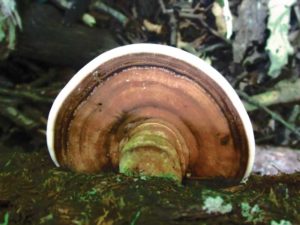
I was introduced to the Old Warner Woods by a mushroom. My daughter and I had walked into the woods looking to find some tall, straight branches along the trunk of a young, wind-felled box-elder. It was late in the winter, during an early thaw that left patches of snow atop the damp brown oak leaves of the year before. A sense of adventure filled the day, and the depths of the woods drew us in. We ventured into a low area covered in crackling, uncertain ice. Our newly-cut branches served to test the strength of the ice before each step, and in places we hopped from one fallen log to another to avoid falling into the ankle-deep slush lurking below. Then we spotted the fallen oak; a giant, with something unusual growing out from its side.
It was nearly two feet across. Brown and rippled on top where the snow had melted away, it was covered a thin layer of green algae; below, it was a smooth, clean white. I had never dreamed that a mushroom could grow so large! I later learned that this was a Ganoderma applanatum, commonly called an Artist Conk. Unlike the shape of mushrooms I was familiar with, it had no stipe, no stem holding up a cap; it was a shelf-mushroom. Unlike more familiar mushrooms, it was a perennial, living year after year, adding a new layer of reproductive tissue that releases spores every summer. Counting the ripples of growth, I determined that this enormous creature was at least 15 years old. As the whole thing was horizontal to the ground, it would seem that the tree itself had fallen at least that long ago.
After half an hour of exploration, photographing this new and magnificent creature, we moved on between the tall trees, discovering the the secret life of a winter wood. A brilliant yellow slime-mold coated the bottom of an abandoned piece of plywood, networked into a branching structure that looked like the branches of a tree, or an aerial view of a river. A standing tree trunk, shattered and staring at the open sky at a height of fifteen feet, contained a mystery; blue heartwood, an unexpected color in the midst of a subdued February color scheme. Brilliant green mosses, exposed to the thin winter light, soaked up the melted snow and took advantage of the brief warm spell. Their reddish-orange reproductive stalks gave the bright green plants a faint orange hue, and my daughter worked to capture a close-up with her cell-phone.
Further along, as she examined more colonies of moss and lichen, I found a hollowed-out log that was full of tiny cap-and-stem mushrooms. An entire community of thousands of eraser-sized caps in shades from tan to gold sheltered from the cold and snow inside this woody cavern. I tried carefully to capture their portrait with my camera, though it was hard to convey my sense of looking at a self-contained world, like a ship in a bottle.
The fallen oaks still teeming with life, the bit of discarded plywood with its yellow slime-mold hiding beneath, the mosses atop their mysterious sandy hummocks; I had discovered the hidden wealth of this scrap of old growth wood, a neglected treasure in the midst of a city of a quarter million people. I would spend the rest of that year wandering through the woods in search of new mushrooms; poring through a handful of field guides, trying to identify the hundred-plus species I encountered during five-hour-long photography expeditions, photographing them and bringing home samples. I tried to capture the essential beauty of these creatures; I sought to prove with my camera that there was beauty and value in this tangled, mosquito-filled wood and swamp.
I’ve always loved nature, but in the desert landscapes of my childhood, humans have always been a marginal guest on the land at the best of times. The balance of rare water and delicate soil is easily disturbed, and it takes very little to unbalance ecological systems, leaving soil barren, unable to sustain life. Here in the water-rich lands of the Midwest, the woods seem to welcome my soft and careful steps on the living earth. Invasive species cause damage to the soil and displace native plants, giving me a chance to give back to the woods which have given so much to me. I weed this wild garden, beating back buckthorn seedlings and defeating patches of garlic mustard; replanting uprooted toothwort and spreading the seeds of wild lilies.
Mushrooms and their oak trees brought me to the woods, and this has been a defining change in my life. Graduate courses taught by Nature herself; slowly learning the phenology of a Wisconsin year, the bulbs in spring, the long tenure of Jack-in-the-Pulpit and mayapples, the open woods transformed into a near-impenetrable thicket of buckthorn branches and creeping grapevines. The Old Warner Woods have offered me question after question; and I’ve diligently searched out answer after answer. Some mysteries go unsolved, unresearched; and in many cases, the events of one year are completely unlike the years before. There will always be more to learn.
Now, whenever I visit the Old Warner Wood, I make a habit of visiting that first fallen oak, full of Ganoderma mushrooms, to give my thanks for the introduction to a whole new world.